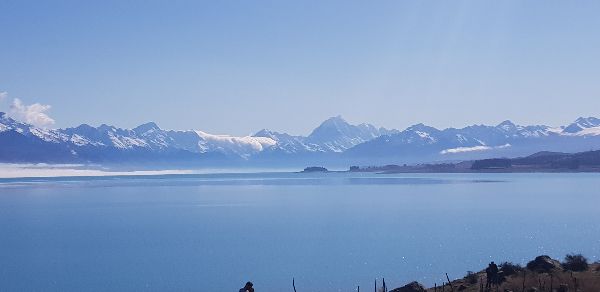Travelling Back In Time: The South Island To Ourselves
New Zealand, until covid year, receives almost four million tourists a year.
It is decades ago since New Zealand had one million visitors a year. But as far as driving goes, this story gets better and better.
We leave Christchurch in a covid two window – with no tourists on the road, no Australians and no Aucklanders, who are in level three lockdown. Heaven week for driving.
It must have been like driving around picturesque South Island in the 1950s and 1960s. Some days there are no cars to overtake at all. Never any long queues of cars behind caravans, campervans – no signs of tourist buses as at all. We saw less than half a dozen campervans or caravans over1450km on the road.
Economic covid times may be tough, but people still save for special holidays to recharge their corporate batteries; for romantic getaways or both.
We stop on the first day and stare at the bright turquoise Lake Pukaki and were gifted one of the best ever views ever of Aoraki (Mt Cook). The great maunga is often not visible from SH8 because it is cloaked in cloud. This was one of those days where Aoraki showed off all its majestic pristine beauty. Maori feel a strong bond with Aoraki, giving mana to their status as tangata whenua. This day, we understand why.
On to Wanaka and the road at times is totally empty but the scenery more magnificent as we tootle through the Mackenzie country, over Dansey’s Pass, turn right past Tarras and to Wanaka. Like Queenstown, Wanaka is becoming too big, too over-populated. It made us think of geese and golden eggs.
So, we move on the much photographed Cardrona Hotel, on the Crown Range road. Oh my god, this ticked our bucket list. We stay there the night swallowed up in the quaint pub’s 157-year-old history – and the cool garden bar before it got too cold.
Cardrona township in its heyday was a prosperous settlement and significant commercial hub for the area. Today it is a watering spot for visitors, mostly local skiers and their families between Wanaka and Queenstown.
Next day, we drive cautiously over the Crown Range and make it into Arrowtown, one of the busiest little tourist spots in Central Otago. But in covid times, you could bowl a ball down the main street and not hit anyone.
There was no bustling atmosphere other than a few other Kiwi tourists; much of the town was closed and it was very cold. We felt for the local hospitality businesses.
At Queenstown, it seemed about half as busy as usual. To me, it is still a touristy town with more appeal for overseas tourists than Kiwis; apart from skiing at the Remarkables or Coronet Peak. What we did enjoy were the views, the grandeur of the amphitheatre and the mulled wine at Eichardt’s bar, overlooking the lake – and great haven for people-watching.
On to Cromwell and we were immediately in awe of the old Cromwell town much of which was lost when the Clyde dam was built on the Clutha River from 1982. Like Oamaru, the signs to the old precinct are not big or clear enough for visitors to really notice and detour.
We park up at Clyde for three nights, enjoying trips to Alexandra, Ophir, Lauder, Omakau, St Bathans, Naseby and Oturehua. The publican at Oturehua says when they are allowed to travel, he gives Aucklanders a jaffa with their coffee. He tells them they are a JAFA – just another friendly Aucklander.
Clyde grew up around the former settlement of Dunstan during the Central Otago goldrush of the 1860s. The town was the most populous in New Zealand during the height of gold fever. These days Clyde is the starting point for the Central Otago152km Rail Trail – gruelling for many; easy for a few.
Our final stop is at Te Konika o te Matamata (Mosgiel), known as the pearl of the Taieri plains. We now feel like we are back in civilisation and our serene covid-free trip has almost come to an end. – Kip Brook



 Gordon Campbell: On Justin Trudeau’s Demise, In A Global Context
Gordon Campbell: On Justin Trudeau’s Demise, In A Global Context Melanie Nelson: Act Now On The Proposed Regulatory Standards Bill
Melanie Nelson: Act Now On The Proposed Regulatory Standards Bill Climate Justice Taranaki: The Bill For Individualism, Corporations And Neoliberalism
Climate Justice Taranaki: The Bill For Individualism, Corporations And Neoliberalism Ministry For Culture & Heritage: New Zealand Flag Half-Masting To Mark The Funeral Of Senior Sergeant Lyn Fleming, NZ Police
Ministry For Culture & Heritage: New Zealand Flag Half-Masting To Mark The Funeral Of Senior Sergeant Lyn Fleming, NZ Police Child Poverty Action Group: Anti-poverty Groups Say Amendments To Social Security Act Will Remove Job Seekers’ Human Rights
Child Poverty Action Group: Anti-poverty Groups Say Amendments To Social Security Act Will Remove Job Seekers’ Human Rights Justice Committee: Justice Committee Reopens Submissions For Principles Of The Treaty Of Waitangi Bill To Tuesday 14 January
Justice Committee: Justice Committee Reopens Submissions For Principles Of The Treaty Of Waitangi Bill To Tuesday 14 January NZCAST: Survivors Of Abuse In Care Left Waiting - Urgent Action Needed Following Apology
NZCAST: Survivors Of Abuse In Care Left Waiting - Urgent Action Needed Following Apology


